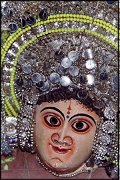Masks of Madhya Pradesh
by Krishnanand Kamat
Page Last Updated: December 07, 2024
The tribals of Madhya Pradesh (topics - map - pictures) in Central India wear the facial masks during festival and ritual dances and call them "Mukhada." They use locally available and most inexpensive materials for the construction of these masks. Usually pumpkin-hollows, waste paper, card board and wood is used in designing the ingenious masks. For an unknown reason, the tribals neither exhibit nor agree to discuss about their masks.
All the masks have a pair of holes to peep through, but they lack similar exits for the nose, mouth and earlobes. These organs are drawn on the mask itself. Honey bee wax is employed to fix nose, pumpkin seeds or rice grains to represent teeth and bangles around eyes. The hair of a goat or a bear is used to denote beard, moustaches and hair. Generally these masks are uncolored, however some of them bear blood-red color. The tribals with an artistic taste may decorate their masks with multi-color designs. They may also use the gloss paper or aluminum foil to get glitter to their mask. At times they fix peacock and other birds plumes for decoration.
It is extremely difficult to preserve these masks beyond a year or two as they are the targets of insects, rats and moisture' attack. The new masks will not be exact replica of one that is destroyed as the poor people have to entirely depend of the material available free of cost. A mask hollowed out of, a pumpkin is circular in shape, gourd is elongated. There are also masks which reminds and resembles a French police or the king of the playing cards.
© K. L. Kamat

Wooden Mask
The tribal communities of Gonda and Raj-gonds follow several of Hindu customs and are great admirers of Lord Krishna. Therefore, their sons and daughters wear masks of the God and Gopis (Krishna's girlfriends) while performing group dances. They have greatest number and variety of masks among the tribals. The Baiga tribals use wood for their masks and hence they are very heavy.
Their youngsters celebrate "Charata" festival in a big way. Quite ahead of the festival day they commence manufacturing their facial masks. On that day dance in groups wearing these masks. The villagers honor them with food and wine. They move to village to village and repeat their performances. The tribals of Bastar District (topics - map - pictures) also perform this festival with all pomp and show. Maria tribal youths also wear similar masks while dancing. Bison horn Marias use the masked which are smeared with red dye.
Database=X:\customersites\kamat.org\kamat.mdb
HyperLinks=01
MaxRows=10
SQL= Select PictureName , ScannedPictures.Caption &
"<p> " & MoreInfo as Caption, Title, ' ' as
Destination from ScannedPictures where PictureName in
('4667.jpg','4666.jpg','4671.jpg','4673.jpg')
Many tribal use masks when they go on hunting expeditions. On an auspicious day, the Buyya tribals invoke god "Kalyadev." Two unmarried youths sport facial masks and numerous ornaments in order to commence their ritual dance. The audience make queries about rain fall, prospects of a good harvest, probable date for the commencement of hunting expeditions and who should be its leader. The dancers sway and reach a state of frenzy. Thus the "possessed" persons suggest remedies to the problems. and questions posed by the people. The villagers consider that these are the dictate of their deity and act accordingly.
![]()
See Also:
- Anthropological Letters -- Picture of a letter written by Krishnanand Kamat to wife Jyotsna from the forests of Madhya Pradesh about the varieties of masks.
- The Children of the Forest God -- Kamats' studies on the tribals of India
- Kamat PictureSearch Results for Mask
|
|
|
|
